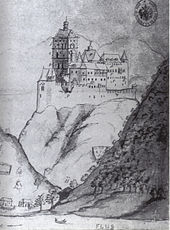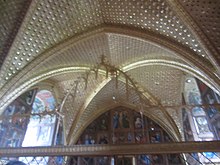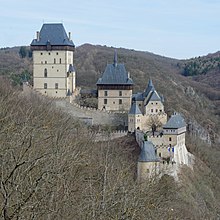Karlštejn Castle
| Karlštejn Castle | ||
|---|---|---|
| Creation time : | 1348 | |
| Castle type : | Hilltop castle | |
| Conservation status: | Preserved essential parts | |
| Place: | Karlstejn | |
| Geographical location | 49 ° 56 '22.9 " N , 14 ° 11' 15.7" E | |
| Height: | 305 m nm | |
|
|
||
The Karlštejn (German (Castle) Karlstein and (castle) Carl Stone , Czech also Karlův Týn ) is located in the municipality Karlštejn 30 km southwest of Prague in the Czech Republic . The hilltop castle was built by Emperor Charles IV and housed the regalia of the Holy Roman Empire from approx. 1350 to 1421 .
history
Karlstein Castle was founded in 1348 by Charles IV after he was first elected Roman-German King (the imperial coronation was not carried out until 1355).
It was laid out as a treasury for the regalia of the Holy Roman Empire and the vast collection of relics of Charles IV. It took ten years for the most important walls to stand, and the construction of the Chapel of the Holy Cross lasted until 1365. The outer walls were supposed to withstand the attempts at conquest, but the imperial regalia were evacuated in the Hussite Wars around 1421 and brought to Nuremberg via Hungary.

The castle first passed in 1422 when the Prague faction of the Hussites besieged it unsuccessfully. In this five trebuchets 9032 stones, 1822 with liquid manure -filled barrels and 22 barrels with fire in the castle thrown. The effects of the manure could be mitigated by unslaked lime . Stone cans were also used. The balls, made from locally available limestone, turned out to be too soft for the wall thickness of the castle, so that finally even stone columns from Prague churches were made into balls.
From 1498 to 1526, Zdeniek Lev von Rosental was appointed first burgrave, then Oberstburggrafen. At the end of the 16th century, by order of Emperor Rudolf II, the outer walls were fortified and renewed again. In 1619 the remaining Bohemian coronation treasures were brought to Prague with the archive. In the dispute between the Bohemian winter king (August 27, 1619 to November 8, 1620) Friedrich von der Pfalz and the Habsburgs , the occupation handed the castle over to Ferdinand II without a fight in 1620 , Roman emperor from August 28, 1619. In 1648 it was conquered by Sweden. The castle was slowly falling into disrepair. It was not until the middle of the 19th century that Emperor Franz II and his son Ferdinand had the castle renovated.
The castle got its current appearance after the renovations, which lasted from 1887 to 1899. The plans come from the architect Friedrich von Schmidt , but they were then changed by Josef Mocker , who was also in charge of the reconstruction.
The nearby villages Budňany and Poučník were combined in 1952 to form the municipality of Karlštejn .
Description of the castle
The individual parts of the castle are at different heights to clarify the meaning. The landmark of the castle is the Great Tower, the floor plan of which is 25 and 17 meters long on the sides. The wall is four meters thick, the northern side seven meters. The main building is the Chapel of the Holy Cross. The Gothic ceiling of the chapel comes from the court painter Charles IV, Master Theodorik . The paintings represent the "Heavenly Army".
The castle does not have a natural well . Miners from Kutná Hora sank a shaft 80 meters deep for a castle well , but did not encounter water. Because of this, water from the nearby Budňanský creek was fed into a cistern . This weak point in the event of a siege was kept secret.
literature
- Franz Auge (ed.): Description of the imperial royal castle Karlstein in Bohemia. 2nd, improved and increased edition. Gerzabek, Prague 1819, digitized .
- Jan Boněk, Thomás Boněk: Karlstein. Eminent Verlag, Prague 2007, ISBN 978-80-7281-317-9 .
- Vinzenz Chyský: Karlstein. History and guide of the castle. Orbis, Prague 1936.
- Frank Dengler: Karlstein and Vincennes - two late medieval castles as symbols of power in comparison. In: Hartmut Hofrichter (Hrsg.): The castle - a cultural-historical phenomenon. Theiss, Stuttgart 1994, ISBN 3-8062-1134-5 (= publications of the Deutsche Burgenvereinigung eV, series B, publications volume 2 and special issue Burgen und Schlösser ), pp. 75–85.
- Michael Eschborn: Karlstein. The riddle of Charles IV's castle. Urachhaus publishing house, Stuttgart 1971, ISBN 3-87838-146-8 .
- Jiří Fajt, Jan Royt: Magister Theodoricus, court painter to Emperor Charles IV. The artistic furnishings of the sacred rooms at Karlstein Castle (exhibition Prague, St. Agnes Monastery, November 12, 1997 - April 26, 1998). National Gallery, Prague 1997, ISBN 80-7035-162-4 (heavily abridged German edition of the Czech exhibition catalog).
- František Fišer: Karlštejn. Vzájemné vztahy tří karlštejnských kaplí. Karmelitánské Nakladatelství, Kostelní Vydří 1996, ISBN 80-7192-169-6 (German summary: Karlštejn - mutual relations between the three Karlštejn chapels ).
- Joseph Neuwirth: Medieval wall paintings and panel paintings of Karlstein Castle in Bohemia (= research on the history of art in Bohemia. Volume 1, ZDB -ID 538768-1 ). Calve, Prague 1896.
See also
Web links
- Castle homepage (English, Czech).
Individual evidence
- ↑ týn is a demarcated place, cf. the Prague district Týn (German: Thein ) and the English word town (German: city )
- ↑ identical to the less recognizable photo from 1870
- ↑ Bernhard Rathgen: The gun in the Middle Ages. Berlin 1928, p. 368.
- ↑ Nicolai Guleke : War Surgery and War Surgeons through the Ages. Gustav Fischer, Jena 1945, p. 5.
- ↑ Rathgen 1928, p. 369.





